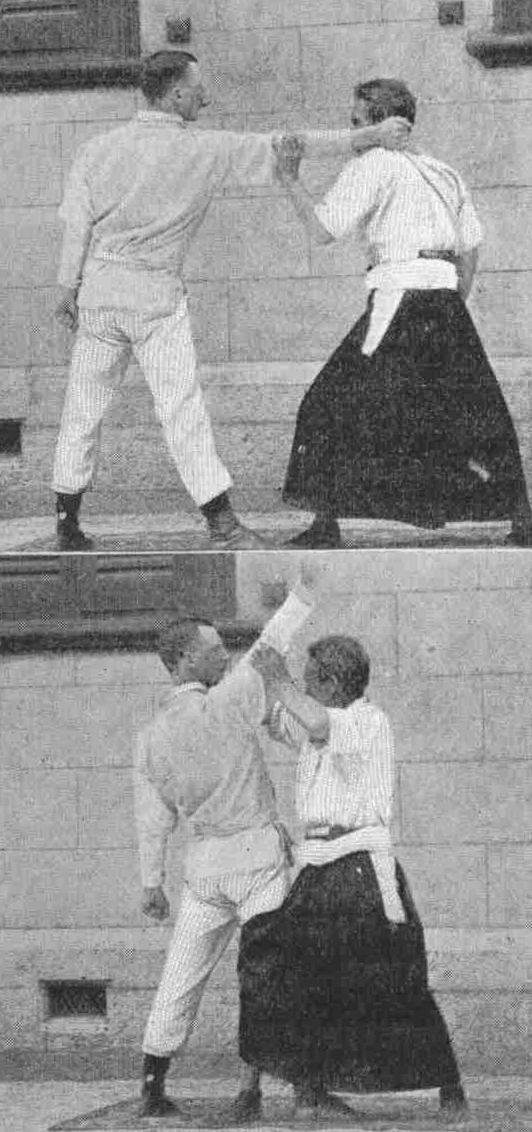- Originally published on the Bartitsu.org site on Sunday, 9th August 2015
The Bartitsu canon consists of the close-combat techniques presented as Bartitsu by E.W. Barton-Wright and his colleagues between the years 1898-1902. Most notably, they include the various jiujitsu kata and Vigny stickfighting set-plays recorded by Barton-Wright in his two article series for Pearson’s Magazine; The New Art of Self Defence (1899) and Self Defence With A Walking Stick (1901).
This article catalogues the atemi-waza (striking and pressure point techniques) represented in Barton-Wright’s New Art of Self Defence articles. Although it’s been confirmed that B-W trained primarily at the Shinden Fudo Ryu dojo of sensei Terajima Kuniichiro in Kobe, we have never been able to positively identify B-W’s demonstration partner in these photo-series, nor exactly which school of jiujitsu is represented. B-W simply referred to studying with a teacher in Kobe who “specialised in the kata form of instruction”.
The most significant details on the Kobe Shinden Fudo Ryu dojo were recorded, not by Barton-Wright, but by Herman Ten Kate, a Dutch anthropologist who met B-W on a steamship from Jakarta to Japan. Ten Kate also trained at the Kobe dojo and, in 1905, wrote an essay for the Dutch magazine De Gids describing their training, “in which all types of randori, kata and atemi are combined”. Te Kate continued that, “in the school of my instructor Terajima, there were more than seventy (kata or defence sequences)”.
Experts in Japanese martial arts history believe that the Shinden Fudo Ryu of Terajima Kuniichiro was distinct from the style of that name commonly associated with the Bujinkan lineage today.
The sixteen kata shown in Barton-Wright’s articles feature thirteen atemi-waza techniques, including:
- hammerfist or backfist strikes to the mastoid process/hinge of the jaw (“behind the ear”)
- direct punch to the “pit of the stomach”*
- rear headbutt
- finger and thumb pressure to the trachea (“tonsil”) and mastoid process
- foot stomp
- thumb pressure to the sciatic nerve
- backfist and double backfists to the face
- thumb pressure to the humerus nerve
- palm-heel strike to the elbow joint
- elbow strikes to the wrists
* N.B. that this strike is part of Barton-Wright’s curious defence with an overcoat against a dagger-wielding attacker, and may actually represent a boxing punch rather than a jiujitsu punch.
New Art of Self Defence, Part 1
“Overcoat trick”: “a right-handed knock-out blow in the pit of the stomach”
#2: “strike your assailant behind the ear with your right fist”
#3: “jerk your head backwards, striking him in the face”
#4: “strike him a back-hander with your right hand”
#4 (alternative technique): “seize his throat with your right hand, forcing your thumb into his tonsil”
#5: “strike him with the right fist behind the ear”
New Art of Self Defence, Part 2
#4: “stamp heavily on your assailant’s right foot” and then “grasp his right leg with your right hand, in the precise position shown in the third photograph, exerting as much pressure as possible with your thumb”
#6: “strike him (or if you are practising the feats with a friend pretend to strike him) in the face with your right fist”
#7: “strike your assailant, simultaneously with both fists, in the face, and bring your elbows down very sharply upon his wrists”
#9: “face your assailant, seizing him just behind the elbow with the thumb and finger of your left hand. Then exert pressure upon the nerve of the funny bone, which is situated just behind the elbow”
#9 (alternative technique): “Should it be found difficult to release your opponent’s hold in the manner described, a sharp upward blow at the elbow joint will have the desired effect.”
Then, “seize him by the throat with your right hand, and throw him upon his back”.
Bonus technique only recorded in the US edition of Pearson’s:
One further atemi-waza technique was described (but not illustrated) in the June, 1899 edition of Pearson’s Magazine published in the United States. The full sequence is reprinted here and the atemi technique requires the defender to “seize him by the throat, pressing your thumb into his tonsil or just under the back of the ear, which is extremely painful”.
Reviewing this list, we note that the mastoid process and trachea are the most common targets and that the atemi techniques serve the same tactical purposes as in most ko-ryu (traditional) jiujitsu curricula, including distracting or interrupting the opponent’s intention, causing momentary imbalance prior to a joint-lock or throw, and creating sufficient space for follow-up techniques.










